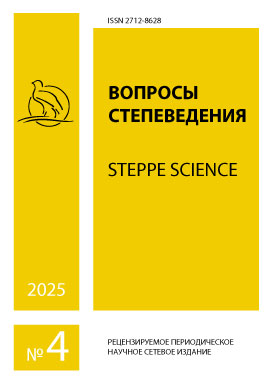© Амирова Т.Н., 2023
УДК 631.8; 528.087
DOI: 10.24412/2712-8628-2023-2-83-90
МЕТОД ВЫЧИСЛЕНИЯ ЭВАПОТРАНСПИРАЦИОННОГО ПОКАЗАТЕЛЯ РАСТИТЕЛЬНОСТИ НА БАЗЕ ДАННЫХ СПУТНИКОВОГО ДИСТАНЦИОННОГО ЗОНДИРОВАНИЯ
Т.Н. Амирова
Институт экологии Национального аэрокосмического агентства,
Азербайджанская Республика, Баку
e-mail: stmz@list.ru
Аннотация: Разработан косвенный метод вычисления показателя эвапотранспирации на базе данных спутникового дистанционного зондирования. Учитывается, что усредненные данные различной растительности, полученные по существующей методике, с применением опорных данных ET0 эвапотранспирации травяного покрытия, содержат изменяющуюся случайную составляющую. Для уточнения предлагается использовать известную регрессионную зависимость ET0 от номера дня года (DOY), представленную аналитически в виде суммы среднего значения и среднего квадратичного отклонения в виде случайной составляющей, изменяющейся во времени. Используя показатель DOY в качестве вспомогательного параметра для определения E, ставится задача определения DOY по дистанционно измеренным показателям NDVI и Fc, учитывая известные регрессионные уравнения. Учет двух параллельно измеряемых показателей дистанционного зондирования позволяет значительно уменьшить случайную погрешность определения DOY по результатам зондирования. Далее указанная случайная составляющая используется взамен случайных составляющих погрешности базовых данных DOY в предположении того, что ETср и соответствующий показатель, полученный дистанционно, совпадают.
Ключевые слова: эвапотранспирация, дистанционное зондирование, ирригация, растительность, почва.
THE METHOD OF CALCULATING THE EVAPOTRANSPIRATION INDEX OF VEGETATION ON THE BASIS OF SATELLITE REMOTE SENSING DATA
T. Amirova
Institute of Ecology of the National Aerospace Agency, Republic of Azerbaijan, Baku
e-mail: stmz@list.ru
Abstract: An indirect method for calculating the evapotranspiration index based on satellite remote sensing data has been developed. It is taken into account that the averaged data of various vegetation obtained using the existing methodology, using ET0 reference data on the evapotranspiration of grass cover, contain a variable random component. For clarification, it is proposed to use the well-known regression dependence ET0 on the number of the day of the year (DOY), presented analytically as the sum of the mean value and the mean square deviation in the form of a random component that varies over time. Using the DOY indicator as an auxiliary parameter for determining E, the task of determining DOY by remotely measured NDVI and Fc, indicators is set, taking into account the known regression equations. Taking into account two parallel measured indicators of remote sensing can significantly reduce the random error in determining DOY based on the results of sensing. Further, the specified random component is used instead of the random components of the error of the basic DOY data, assuming that ETср and the corresponding indicator obtained remotely coincide.
Key words: evapotranspiration, remote sensing, irrigation, vegetation, soil.
Список литературы:
1. Wanniarachchi S., Sarukkalige R. A review on evapotranspiration estimation in agricultural water management: Past, present and future // Hydrology. 2022. vol. 9. no. 7. 123. DOI: 10.3390/hydrology9070123.
2. Isgandarov M.Y. Melioration and ecological state of soils, based on draining degree of Kura-Aras lowland // Scientific Journal “ScienceRise”. 2015. no 2. pp. 91-93 DOI: 10.15587/2313-8416.2015.37212.
3. Maina M., Amin M., Rowshon M., Aimrun W., Samsuzana A., Yazid M. Effects of crop evapotranspiration estimation techniques and weather parameters on rice crop water requirement // Aust. J. Crop Sci. 2014. no. 8. pp. 495-501.
4. Van M.S., Tol R., Linker R., Reyes-Lastiri D., Kootstra G., Koerkamp P.G., Henten E.G. Introductory overview: systems and control methods for operational management support in agricultural production systems // Environ. Model. Softw. 2021. vol. 139. 105031.
5. Vanschoenwinkel J., Van Passel S. Climate response of rainfed versus irrigated farms: The bias of farm heterogeneity in irrigation // Clim. Chang. 2018. vol. 147. pp. 225-234.
6. Jaramillo S., Graterol E., Pulver E. Sustainable transformation of rainfed to irrigated agriculture through water harvesting and smart crop management practices // Front. Sustain. Food Syst. 2020. no. 4. 437086.
7. Water in agriculture. Available online. [Электронный ресурс]. URL: https://www.worldbank.org/en/topic/water-in-agriculture#1 (дата обращения: 04.10.2022).
8. Altobelli F., Meybeck A., Gitz V. Accounting for water use in agriculture // In knowledge and information for sustainable food Systems. Rome, Italy. 2014. [Электронный ресурс]. URL: https://www.researchgate.net/publication/328773127 (дата обращения: 04.10.2022).
9. Liou Y.A., Kar S.K. Evapotranspiration estimation with remote sensing and various surface energy balance algorithms – A review // Energies. 2014. vol. 7. pp. 2821-2849.
10. Eliades M., Bruggeman A., Djuma H., Christofi C., Kuells C. Quantifying evapotranspiration and drainage losses in a semi-arid nectarine Field with a dynamic crop coefficient (KC) derived from leaf area index measurements // Water. 2022. vol. 14. pp. 734.
11. Shuttelworth W. Evaporation models in hydrology // In land surface evaporation measurement and parameterization. NY, USA. 1991. pp. 93-120.
12. Monteith J.L., Unsworth M.H. Principles of environmental physics. 2nd Edition. Butterworth-Heinemann, Elsevier, Oxford, 1990. 291 p.
13. Calera A., Campos I., Osaan A., Durso G., Menenti M. Remote sensing for crop water management: from ET modelling to services for the end users // Sensors. 2017. vol. 17. 1104. DOI: 10.3390/s17051104.
14. Johnson L.F., Trout T.J. Satellite NDVI assisted monitoring of vegetable crop evapotranspiration in California’s San Joaquin Valley // Remote Sens. 2012. no. 4. pp. 439-455. DOI: 10.3390/rs4020439.
Для цитирования: Амирова Т.Н. Метод вычисления эвапотранспирационного показателя растительности на базе данных спутникового дистанционного зондирования // Вопросы степеведения. 2023. № 2. С. 83-90. DOI: 10.24412/2712-8628-2023-2-83-90.





